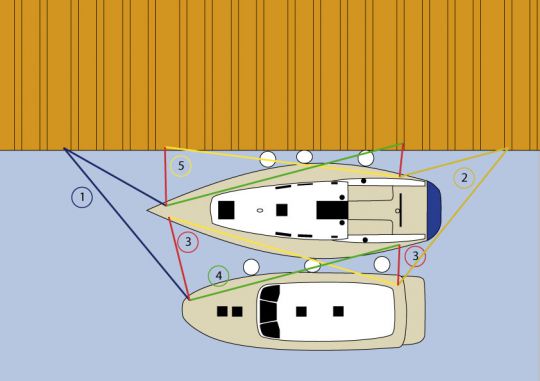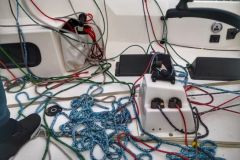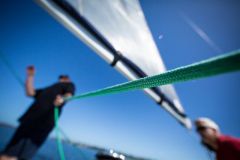It's unlikely that a boater would be so careless as to refuse to allow you to couple up with his boat. But beware of the homonym, because he may legitimately refuse to couple with your boat or even oppose a "coupling" of your boats.
Since the middle of the 16th century, mooring in pairs has meant putting the pairs of one boat (and therefore its side) against the pairs of another. One can find one, two, three and sometimes 4 boats against each other.
So we sailors can safely say "couple up at trois?!" However, we will avoid saying treble , in trio or dock in a threesome .

Torque mooring differs very little from mooring along a wharf. As you approach, you will need to consider a few criteria in order to choose the "right" boat. And in order to tie up properly, a few simple precautions will allow you to succeed in this manoeuvre.

Choices to be made for torque mooring
- The size of the ship that receives us
You will choose a boat of a length comparable to yours. Ideally, you should be able to moor alongside a slightly larger boat. - The height of the freeboard
Select a vessel with a freeboard comparable to yours. In addition to the comfort obtained when passing from one vessel to another, this will prevent the stanchions from ending up under the lines of the other vessel. - The shape of the hull.
Some ships have incompatible shapes for a twin mooring. A boat with a very tuliped hull will have difficulty finding its place alongside a sailboat of the same size, as the fenders will not adequately support the dead works. - The rigging
This is the most sensitive point when mooring a couple of sailing yachts. It is imperative to ensure that the spreaders cannot collide or even touch each other. During the manoeuvre, position the boats so that the rigging is at least 1 m apart. In general, it is a good idea to moor upside down to keep the rigging away from each other and make it easier to move from one boat to another. - The weight of the boats
A very heavy vessel, made of steel or wood, should not be paired with a more fragile craft at the risk of damaging it. If you are on the small boat at the dock, do not hesitate to leave your place and you will maneuver to get in line with the arrival.

The right use and manners to get in a relationship
If for reasons of intimacy or tranquility you do not appreciate the couple mooring, take the opportunity to spend the night or the afternoon at anchor. You will be able to enjoy space and peace and quiet without hindrance. But sometimes we don't have a choice, so it's best to be prepared and respect a few rules.
- It is customary to accept a couple boat and sometimes it is the captain's office that requires it. But this is no reason to refrain from making a polite request to the captain, if he is on board.
- On approach, maneuver very cleanly. The neighbouring boat must be calmed down when arriving with calmness and assurance. Prepare enough fenders and hawsers so as not to be caught off guard.
- If the boat you are relying on is leaving in a short time, make sure you stay on board for the harbour manoeuvre or change places.
- During (peaceful) boarding, avoid grasping a candlestick to stop your boat's course. Climb aboard the neighbour without a crash: a successful manoeuvre is never done in a hurry.
- And at night, be especially discreet, as the sleeper awake with a boot on the deck is rarely in a good mood.
- When you move from one boat to another, to preserve a little privacy, it's through the beach before that you move around as stealthily as possible.

Coupled, the mooring is done on land
As you come alongside the boat, you hit your moorings on your neighbour's cleats, starting with the ferries and the guards. But the boat you're leaning on is not meant for you tenir?!
Then, as far as possible, you will wear the hawsers as a point on the ground. Your moorings, especially your guards, stabilize the position of the boats (watch out for the spreaders).
Torque mooring diagram

- 1- Front spikes
- 2- Rear spikes
- 3- Crossbars
- 4- Front guards
- 5- Rear guards
Finally, one can question port tariffs and practices when they ask to be paired.
Indeed, accessing the pontoon by crossing three front beaches with young children is not easy. Or being woken up by the din of a festive crew returning (as they can) to their board can make you regret mooring with a couple.
It is regrettable that in general the captain's offices charge the same rates whether you are alone at the pontoon or accompanied by 3 boats as a couple, whereas the yachtsman does not have the same services.










